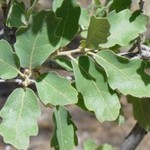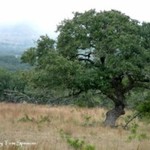 SALT LAKE CITY — A hybrid scrub oak that looks like a tall, overgrown shrub in a Salt Lake City historical park is a rare and ancient tree from a time when Utah and the Great Basin were warmer and wetter. The branches of the 15-foot-high tree cover nearly an acre a few feet east of the Mary Fielding Smith house at This is the Place Heritage Park.
SALT LAKE CITY — A hybrid scrub oak that looks like a tall, overgrown shrub in a Salt Lake City historical park is a rare and ancient tree from a time when Utah and the Great Basin were warmer and wetter. The branches of the 15-foot-high tree cover nearly an acre a few feet east of the Mary Fielding Smith house at This is the Place Heritage Park. "This tree is significant because it provides evidence of climate change," said Chuck Wullstein, a retired University of Utah biology professor. "There had to be a warm climate for it to be here."
Only about a dozen of the trees exist between Salt Lake City and St. George. They are between 5,000 and 7,000 years old.
The oak is an indicator that the Earth's climate and ecosystems have changed drastically several times.
"We live with a world view that the things that are around us are the way they have always been and always will be," says Ron Neilson, an Oregon State University-based bioclimatologist for the U.S. Forest Service.
Neilson did groundbreaking research on the Great Basin's scrub oaks and climate at the University of Utah. Now, he travels the country speaking to scientists and politicians about global warming.
The hybrid oak has its origins in the warmth-loving canyon live oak, or Quercus turbinella, and the cold-resistant Gambel oak, or Quercus gambelii.
"They met here on the Wasatch and hybridized," said Wullstein.
But when the climate cooled again and frost
became a regular part of the ecosystem, the canyon live oak's range retreated south to what is now Utah's Dixie. That climate change should have killed the hybrid. But a few managed to survive in warmer, wetter pockets of the Wasatch and Oquirrh mountains, where they were discovered in 1954 by botanist Rudy Drobnick.
That climate change should have killed the hybrid. But a few managed to survive in warmer, wetter pockets of the Wasatch and Oquirrh mountains, where they were discovered in 1954 by botanist Rudy Drobnick.
A team of biologists led by the University of Utah's W.P. Cottam confirmed the hybrid by artificially pollinating the oaks and raising the offspring in a greenhouse. "Biologists came from all over the world to see them," said Wullstein. They can still be seen at the Cottam Hybrid Oak Grove on campus.
The hybrid Wullstein found in the park grows near a small, watercress-ringed spring. The tree gets added warmth because it is at the elevation of the valley's warm inversion layer.
"These trees are important because they are living fossils," said Neilson. "They are literally five- or six-thousand years old, and they are still living."
Rod Clifford, spokesman for the park, said managers are aware of the hybrid.
"We are committed to making sure they are protected and kept safe," he said.
http://www.sltrib.com/ci_6287303



